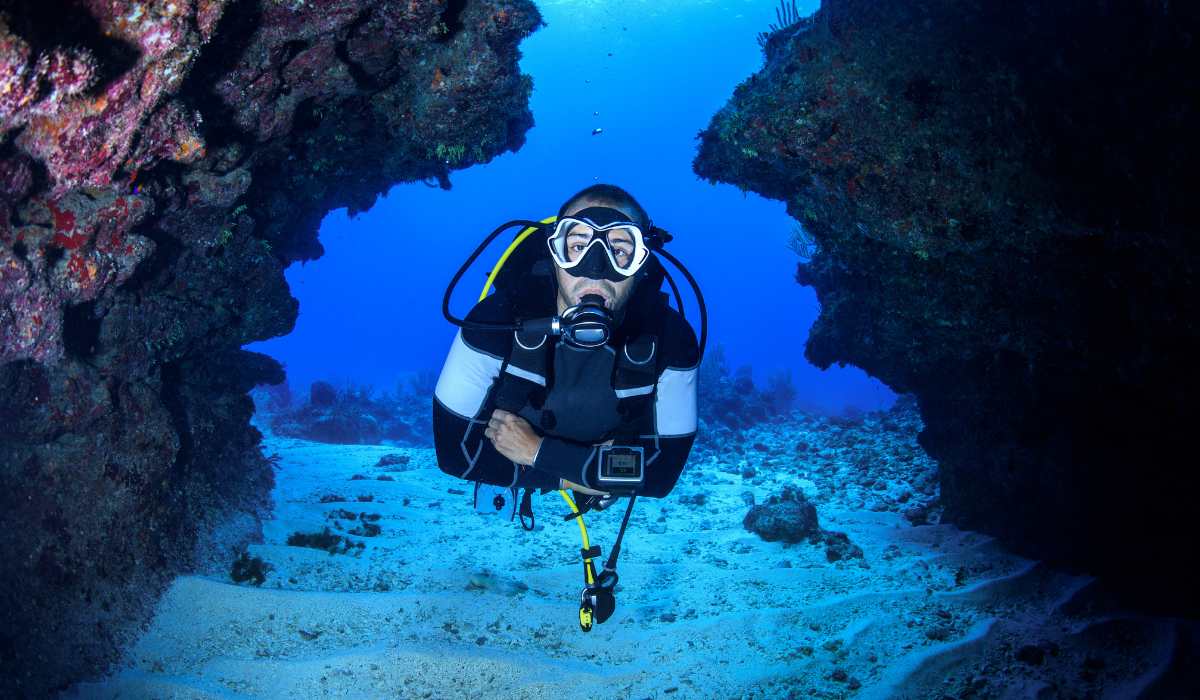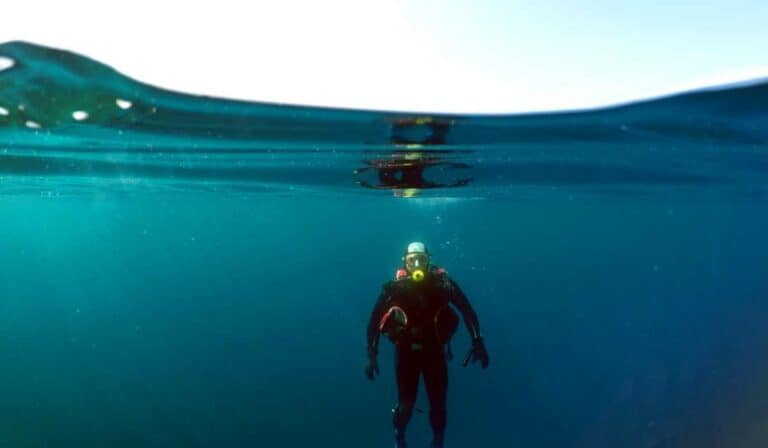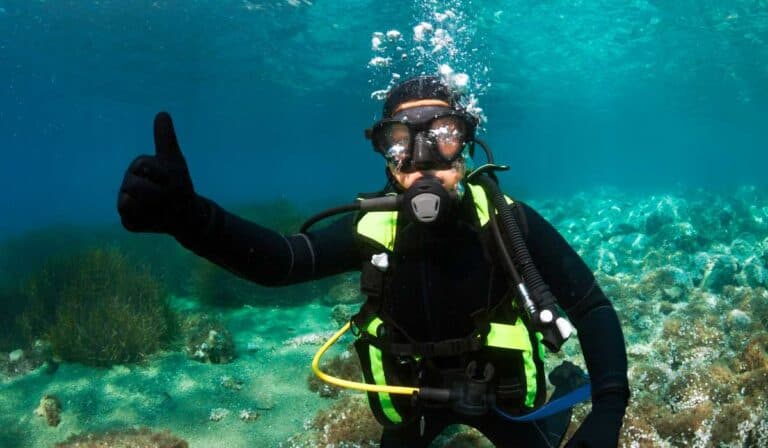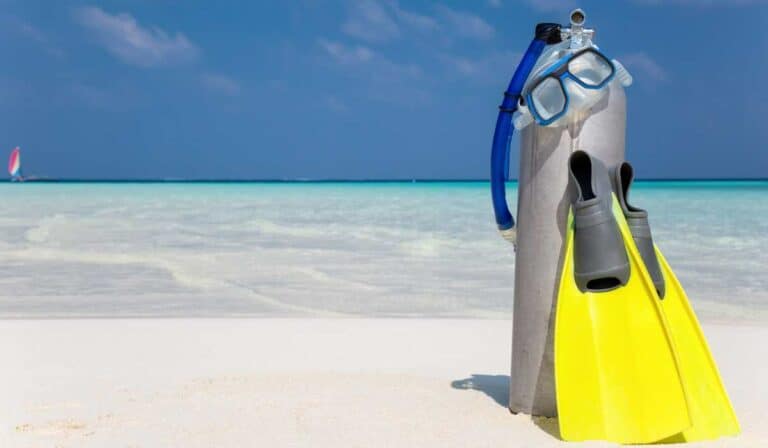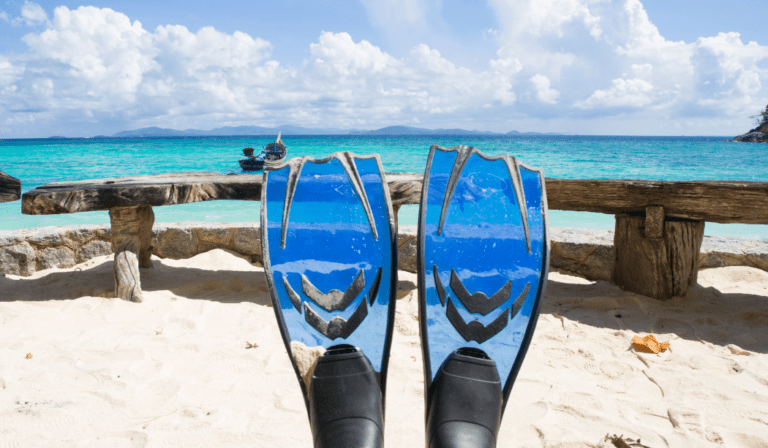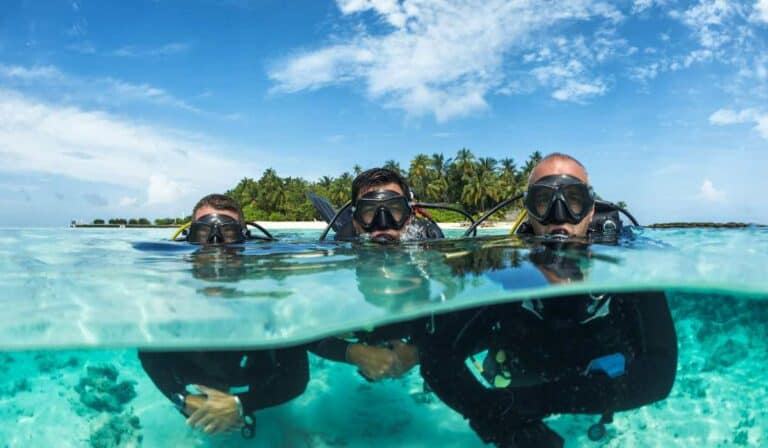How To Shoot The Best Video While Scuba Diving
Capturing stunning footage of marine life and underwater landscapes is an art form that requires knowledge, practice, and the right equipment. In this blog post, we’ll take you through the steps to creating stunning underwater videos.
We’ll start by discussing how to choose the perfect camera for scuba diving videography. Next, we’ll delve into essential accessories that will elevate your underwater photography skills.
Following that, we’ll share tips on capturing mesmerizing shots beneath the surface and explore techniques such as manual focus and adjusting frame rates. We will also discuss editing your footage to create visually striking content.
Finally, we’ll provide advice on sharing your captivating underwater videos with others so they too can experience the wonders of our planet’s aquatic environments.
Table of Contents
1. Choosing the Right Camera for Scuba Diving

To capture the beauty of underwater adventures, a camera suitable for scuba diving photography is necessary. However, not all cameras are suitable for scuba diving photography. This article will explore the top camera choices for capturing those aquatic moments, including waterproof and action cameras.
Waterproof Cameras vs Action Cameras
Waterproof cameras, such as Olympus Tough series, are designed with built-in waterproof features that allow them to be submerged without needing a separate housing. These cameras typically have excellent image quality and can capture both still images and videos at various depths.
Action cameras, like GoPro Hero series, are compact devices built for rugged use in extreme conditions – including underwater environments. They often come with waterproof housings or cases which make them ideal for scuba diving videography. While they may lack some advanced features found in high-end waterproof models, action cameras provide great value for money while delivering impressive results.
Mirrorless & DSLR Cameras: A Step Up For Professionals
If you’re a professional photographer or looking to take your underwater videography skills up a notch, consider investing in a mirrorless or DSLR camera along with an appropriate underwater housing system like those from Aquatica Digital. These systems offer superior image quality and control over settings compared to standard waterproof or action cameras but do come with a higher price tag.
Key Features to Look for in an Underwater Camera
- Depth Rating: Ensure the camera or housing system you choose is rated for the depths you plan on diving. Most waterproof cameras and action cameras can handle depths of up to 30-40 meters, while professional housings may go beyond 100 meters.
- Image Quality & Resolution: Choose a camera that offers high-resolution video capabilities (4K or Full HD) and has good low-light performance, as underwater environments often have limited natural light.
- Battery Life: Long battery life is essential when scuba diving, so look for models that offer extended shooting times without needing frequent recharging or battery swaps.
- User-Friendly Controls: Navigating through settings and controls can be challenging underwater. Opt for cameras with intuitive menus and easily accessible buttons that are designed specifically for use in aquatic conditions.
Click here to read about Scuba Certifications and Depth Limits! A Guide
2. Shooting the Best Underwater Video Footage
Now that you have the right camera for the job, it’s time to start shooting. Here are some tips to help you capture great footage while scuba diving:
Frame Rate and Camera Settings
When shooting underwater video, it’s important to choose the right frame rate and camera settings. A higher frame rate (60fps or higher) will allow you to capture slow-motion footage, while a lower frame rate (24fps or 30fps) will give your footage a more cinematic look. Adjust your camera’s aperture, shutter speed, and ISO settings to get the best exposure for the lighting conditions you’re in.
Shooting Macro
Macro videography is all about capturing the small details of marine life. Use a macro lens or setting on your camera to get up close and personal with your subjects. Be patient and wait for your subject to settle down before shooting, and use a steady hand or tripod to keep your camera steady.
Capturing Marine Life
When shooting underwater videos, it’s important to capture the beauty of the marine life around you. Swim slowly and avoid sudden movements that could scare away your subjects. Use manual focus to ensure your subject is in focus, and change your depth to get different perspectives.
Keeping Your Camera Steady
Underwater currents can make it challenging to keep your camera steady while shooting. Use a stabilizing device like a tripod or monopod to keep your camera steady, or hold your camera close to your body to reduce movement. You can also use your fins to stabilize yourself while shooting.
Key Takeaway:
This section discusses the best camera options for scuba diving videography, including waterproof cameras like the Olympus Tough series and action cameras such as the GoPro Hero series. It also provides tips on shooting great underwater video footage, such as adjusting frame rate and camera settings, capturing marine life with manual focus, and using stabilizing devices to keep your camera steady.
3. Essential Accessories for Scuba Diving Photography

To capture the best underwater videos while scuba diving, you’ll need more than just a camera. There are several essential accessories that can help improve your shots and make your experience even better. In this section, we’ll look at the essential accessories for scuba diving photography.
Lighting Equipment
Underwater lighting is crucial to capturing vibrant colors and clear images in your videos. Natural light diminishes quickly as you dive deeper, so investing in good quality underwater video lights is highly recommended. Some popular options include compact LED lights or powerful strobes that attach directly to your camera housing.
Filters
Using filters can greatly enhance the color balance of your underwater footage by compensating for the loss of reds and other warm tones at depth. A red filter, for example, helps bring out these warmer hues in blue water environments while a magenta filter works well in green water conditions. Other filters to consider include:
- Polarizing Filter: Reduces glare from reflective surfaces like fish scales or sandy bottoms.
- Macro Lens: Allows close-up shots of small marine life with greater detail and clarity.
- Dome Port: Enhances wide-angle shots by reducing distortion caused by flat ports on camera housings.
Click here to read about 5 Best Places for Scuba Diving in Hawaii
Tripods & Stabilizers
A steady shot is key when filming underwater, and using a tripod or stabilizer can help you achieve this. A tripod is ideal for stationary shots, while a handheld stabilizer like the GoPro Karma Grip provides smooth footage when moving through the water.
Camera Housing & Mounts
For underwater photography, a waterproof housing compatible with your camera is essential to ensure its safe operation at the desired depths. Make sure it’s rated for the depths you plan on diving and has easy access to all necessary controls. Additionally, consider investing in various mounts such as wrist straps or tray systems that allow hands-free operation while scuba diving.
Extra Batteries & Memory Cards
Don’t miss out on capturing incredible moments due to dead batteries or full memory cards. Always bring extra fully charged batteries and high-capacity memory cards so you’re prepared during your dive.
By equipping yourself with these essential accessories, you’ll be well-prepared to capture stunning underwater videos during your scuba diving adventures.
To capture stunning underwater shots, it is essential to have the right accessories for scuba diving photography. Now let’s move on and discuss tips for capturing those breathtaking photos beneath the surface of the water.
Key Takeaway:
To shoot the best video while scuba diving, it is essential to have underwater lighting equipment and filters that enhance color balance. Using a tripod or stabilizer can help achieve steady shots while investing in camera housing and mounts ensures hands-free operation. Additionally, always bring extra batteries and memory cards to avoid missing out on capturing incredible moments during your dive.
4. Tips for Capturing Stunning Underwater Shots
Diving into the deep blue sea and capturing its beauty on camera can be an exhilarating experience. However, underwater photography presents unique challenges that require specific techniques to achieve stunning results. Here are some tips to help you capture breathtaking scuba diving videos:
Utilize Natural Light
The sun’s rays penetrate water differently than air, creating a mesmerizing effect in your underwater shots. Whenever possible, use natural light by positioning yourself close to the surface or near openings where sunlight enters the water. Keep in mind that colors fade as you descend deeper due to light absorption, so adjusting your white balance settings may be necessary.
Maintain Steady Camera Movements
A stable shot is crucial for producing high-quality videos while scuba diving. To minimize shaky footage, hold your camera with both hands and keep it close to your body while swimming slowly and deliberately through the water. Using a tripod or monopod can also provide additional stability when shooting stationary subjects.
Get Close to Your Subject
- Minimize distance: The closer you are to your subject, the clearer and more vibrant they will appear in your video since there will be less water between them and the lens.
- Framing: Filling up most of the frame with your subject helps create captivating visuals that draw viewers’ attention.
- Safety first: Remember not to get too close if photographing potentially dangerous marine life; always prioritize safety over getting an impressive shot.
Click here to read about 5 Best Places for Scuba Diving in Hawaii
Experiment with Different Angles and Perspectives
Underwater scenes can look vastly different depending on the angle you shoot from. Try experimenting with various perspectives, such as shooting upwards towards the surface to capture sun rays or getting low to photograph marine life against a backdrop of coral reefs. Don’t be afraid to think outside the box when it comes to framing your shots.
Be Patient and Observe Your Surroundings
Patience is key in underwater photography, as marine life may not always cooperate or appear where you expect them. Take time to observe your surroundings and anticipate potential subjects’ movements before pressing the record. This will help ensure that you’re ready for those once-in-a-lifetime moments when they happen.
By heeding these pointers, you can create stunning footage of the subaquatic world that will leave viewers captivated.
With the right preparation and technique, you can capture stunning underwater shots. Now let’s move on to editing your videos for a truly professional look.
Key Takeaway:
To capture stunning scuba diving videos, utilize natural light by positioning yourself near openings where sunlight enters the water and maintaining steady camera movements. Get close to your subject while prioritizing safety over getting an impressive shot, experiment with different angles and perspectives, be patient, and observe your surroundings for those once-in-a-lifetime moments.
5. Editing Your Underwater Videos

Diving into the world of video editing can be intimidating, but with the right tools and some patience, you’ll be able to transform your raw underwater footage into a captivating masterpiece. In this section, we’ll discuss some essential steps for editing your scuba diving videos.
A. Choosing Video Editing Software
The first step in editing your underwater videos is selecting the right video editing software. When selecting the right video editing software for your underwater videos, there are a variety of options available from free programs such as iMovie or Windows Movie Maker to more advanced paid versions like Adobe Premiere Pro and Final Cut Pro X; thus, consider factors like ease of use, compatibility with your computer’s operating system, and features when making your decision. Consider factors like ease of use, compatibility with your computer’s operating system, and available features when making your decision.
B. Color Correction and Grading
Underwater videography often results in washed-out colors due to limited light penetration and color absorption at depth. To bring out vibrant hues in your footage, you’ll need to perform color correction during post-production using tools within your chosen video editor:
- White Balance: Adjusting white balance helps remove unrealistic color casts by telling the software what should appear as pure white in an image.
- Saturation: Increasing saturation will enhance overall vibrancy by intensifying all colors present in a shot.
- Hue/Saturation Curves: These allow for precise adjustments of individual color channels (red/green/blue) so that specific tones can be targeted without affecting others.
C. Stabilization and Transitions
Motion sickness-inducing shaky footage is a common issue when filming underwater. To counteract this, apply stabilization effects within your video editing software to smooth out any unwanted camera movement. Additionally, use transitions like crossfades or wipes between clips to create seamless connections and maintain viewer engagement.
D. Adding Music and Sound Effects
Enhance the atmosphere of your scuba diving videos by incorporating royalty-free music or sound effects that complement the visuals. Be mindful of audio levels so that background music doesn’t overpower natural sounds captured during your dive, such as bubbles or marine life noises.
E. Exporting Your Final Video
Once you’re satisfied with the edits, export your video in a suitable format for sharing online (e.g., MP4) at an appropriate resolution and compression settings for optimal playback quality without excessively large file sizes. Ensure that you choose an appropriate resolution (1080p HD is recommended) and compression settings for optimal playback quality without excessively large file sizes.
Editing your subaquatic footage can be a fulfilling endeavor that lets you record the ocean’s splendor and show it to others. Once you’ve got the know-how, tools, and methods, it’s time to start showing off those spectacular aquatic clips with your loved ones.
Key Takeaway:
To edit scuba diving videos, you need to choose the right video editing software and perform color correction using tools like white balance, saturation, and hue/saturation curves. Additionally, apply stabilization effects and transitions to smooth out unwanted camera movement while adding royalty-free music or sound effects that complement the visuals before exporting your final video in a suitable format for sharing online.
Click here to read about Scuba Divers: 7 Essential Ways To Save The Oceans For the Future
6. Sharing Your Underwater Videos with Others
Now that you’ve completed the process of recording and refining your captivating underwater footage, it’s time to broadcast them to everyone. There are several ways to showcase your scuba diving adventures and connect with fellow enthusiasts. In this section, we’ll explore various platforms to share your videos and discuss how to make them stand out.
Social Media Platforms
- Instagram: A visual platform perfect for showcasing short clips or highlights from your dives. Use relevant hashtags like #scubadiving, #underwatervideo, or #marinelife to increase visibility. Don’t forget to tag locations and collaborate with other divers by tagging their accounts in your posts.
- Facebook: Share longer videos on Facebook by uploading directly or linking from YouTube or Vimeo. Joining scuba diving groups can also help you reach a wider audience interested in underwater videography.
- YouTube: The go-to platform for video content creators; upload full-length dive footage along with shorter highlight reels of memorable moments. Optimize titles, descriptions, and tags using keywords related to scuba diving and underwater videography.
Create a Website or Blog Dedicated To Your Scuba Diving Adventures
If you’re passionate about scuba diving photography and want a dedicated space online where people can find all of your work easily – consider creating a website or blog focused on this niche hobby. This allows you more control over presentation while providing an opportunity for viewers who appreciate quality content specifically tailored towards their interests. You can use website builders like Wix, Squarespace, or WordPress to create a professional-looking site with ease.
Participate in Online Communities and Forums
Becoming an active member of online communities related to scuba diving, underwater photography, and videography can help you connect with like-minded individuals who share your passion. These platforms provide opportunities for sharing tips, and advice and showcasing your work. Some popular forums include:
- ScubaBoard: A large community dedicated to all things scuba diving.
- Wetpixel Underwater Photography Forums: A forum specifically focused on underwater photography and videography techniques.
- Diving Photo Guide Forum: Another platform where divers discuss gear recommendations, shooting techniques, dive destinations, and more.
Key Takeaway:
After capturing and editing your scuba diving videos, it’s time to share them with the world. You can use social media platforms like Instagram or Facebook, create a website or blog dedicated to your adventures, and participate in online communities and forums related to underwater photography and videography. Use relevant hashtags, and optimize titles and descriptions using keywords related to scuba diving for better visibility on these platforms.
Click here to read about A Guide To Scuba Diving in Honduras
Conclusion
In conclusion, shooting the best video while scuba diving requires choosing the right camera and essential accessories for underwater photography. Additionally, following tips such as getting close to your subject, using natural light, and having steady shots can help you capture stunning footage. Editing your videos with color correction and adding music or sound effects can enhance the final product.
Show off your underwater journeys and motivate others to appreciate the oceans’ loveliness by sharing your videos. Remember to always prioritize safety while scuba diving and respect marine life by not disturbing their habitats.
If you’re ready to start capturing amazing footage on your next scuba diving trip, check out Sun Water Dirt for all of your gear needs!

